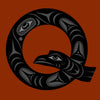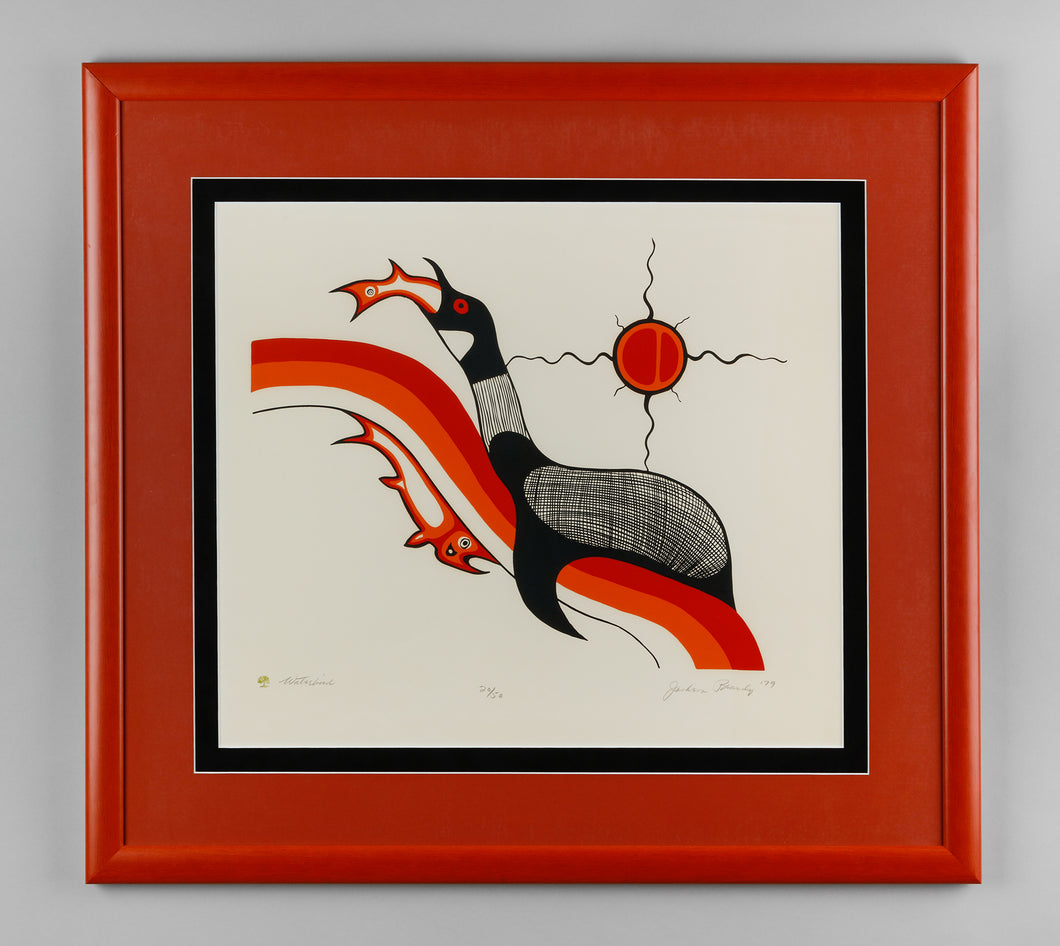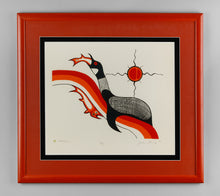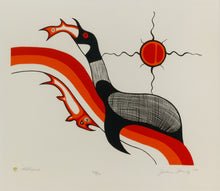Waterbird by Jackson Beardy (1944-1984), Ojibwe and Cree Nations
Regular price
$950.00
Sale
Waterbird, 1979
by Jackson Beardy (1944-1984), Ojibwe and Cree Nations
silkscreen, Edition of 50
28.5" high x 31" wide framed
Jackson Beardy was born on Garden Hill Reserve, Island Lake, Manitoba in 1944. Throughout his life, he was an artist, storyteller, teacher, consultant, and a strong advocate for Indigenous people and artists. Following tradition, at a young age, he went to live with his paternal grandmother and learned many traditional Ojibwe and Cree stories that would inspire his artistic practice in the future. After attending a residential school in Portage la Prairie which left a huge impact on him, he attended the Technical Vocational High School in Winnipeg from 1963 to 1964. He had his first exhibition at the Winnipeg Art Gallery in 1965 and then completed his formal education at the University of Manitoba in 1966. Even though his artworks were not always accepted within his community, Beardy finally found the freedom to depict the oral legends and stories that he listened to as a child into his artworks.
During the 1960s and 1970s Indigenous peoples and their art were going through a time of change and ground-breaking. As a result of political changes such as getting the right to vote and being included in the Expo 67 Indigenous art started slowly getting recognition. At that time the prevailing opinion was that Indigenous art is depicting a dying culture, dealing with old legends, not being contemporary or relevant to the current issues and therefore it was seen as something belonging to the ethnographic field rather than the art field. The discussions were also about a question if this is actually art or craft and therefore should it be presented at the mainstream art galleries. In addition, issues of racial discrimination were widely spread. A distressing example is that Beardy was denied entry to the exhibition opening at the National Arts Centre in Ottawa where his works were presented. It is no surprise that Beardy would become a spokesperson for Indigenous creatives and communities from that moment onward.
Beardy was a founding member of the group formed in Winnipeg called the Professional National Indian Artists Inc. in 1972, commonly known as Indian Group of Seven, along with Daphne Odjig, Alex Janvier, Norval Morrisseau, Carl Ray, Joseph Sanchez and Eddy Cobiness. As a collective, they organized exhibitions, created funding opportunities for emerging Aboriginal artists, controlled the production and marketing of their art, and developed new ways to educate the public about Indigenous art and culture. The group was also known as the Woodland School of Art since each artist conveyed their relationship to the natural world. Their contribution was instrumental in opening the doors for future First Nations artists to gain acceptance and recognition in art institutions.
During the early 1980s, Beardy’s belief in protecting and supporting the rights of Indigenous artists led him to become an art advisor and cultural consultant at the Manitoba Museum of Man and Nature. He also taught as a professor in the Department of Native Studies at Brandon University and at the University of Manitoba. From 1982 through 1983, Jackson Beardy was senior arts advisor to the Federal Department of Indian Affairs and Northern Development in Ottawa.
In 1984, Beardy returned to Winnipeg to paint a mural called Peace and Harmony for the Indigenous (Indian) Family Centre in one of the earliest mural sites in the province. Unfortunately, Beardy passed away before he could finish the project. His untimely death was the result of complications following a heart attack. The mural was completed by student artists at R.B. Russell Vocational High School, the next year. The wall painting captures Beardy’s vision of imagining a reality where humanity, nature, and the spiritual realm live in unity with one another. The Winnipeg Art Gallery held a retrospective of his work in the exhibition Jackson Beardy: A Life’s Work in 1993-94 as recognition of his contributions to art and Indigenous communities.



